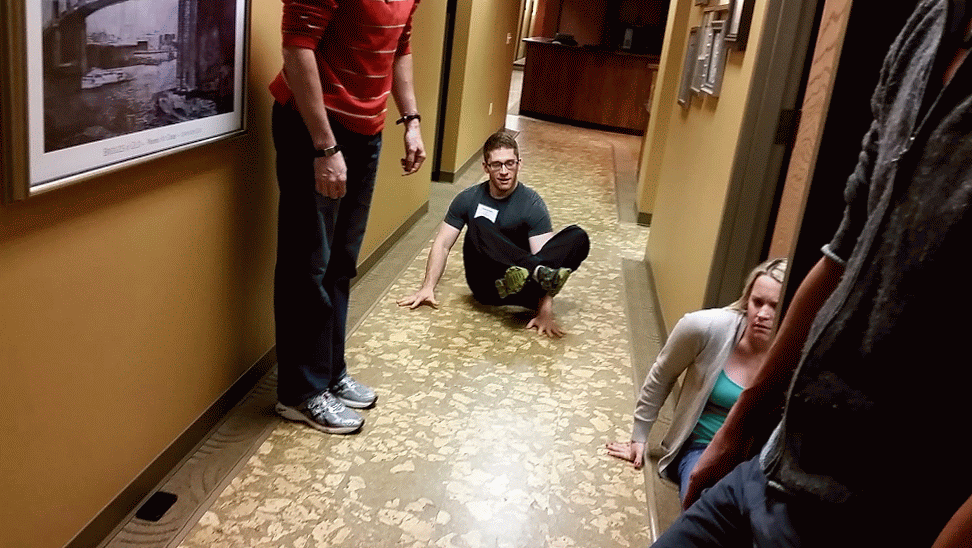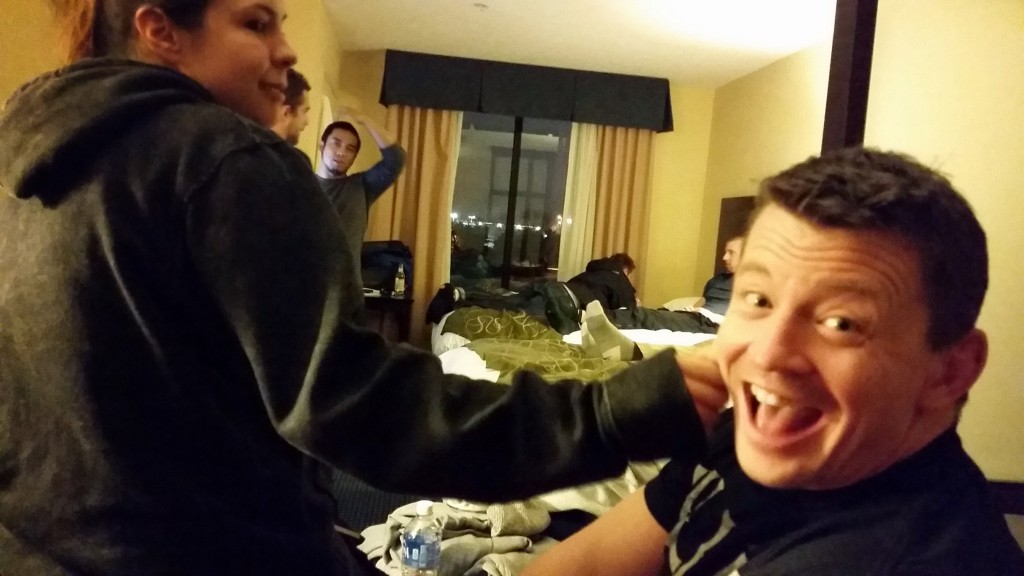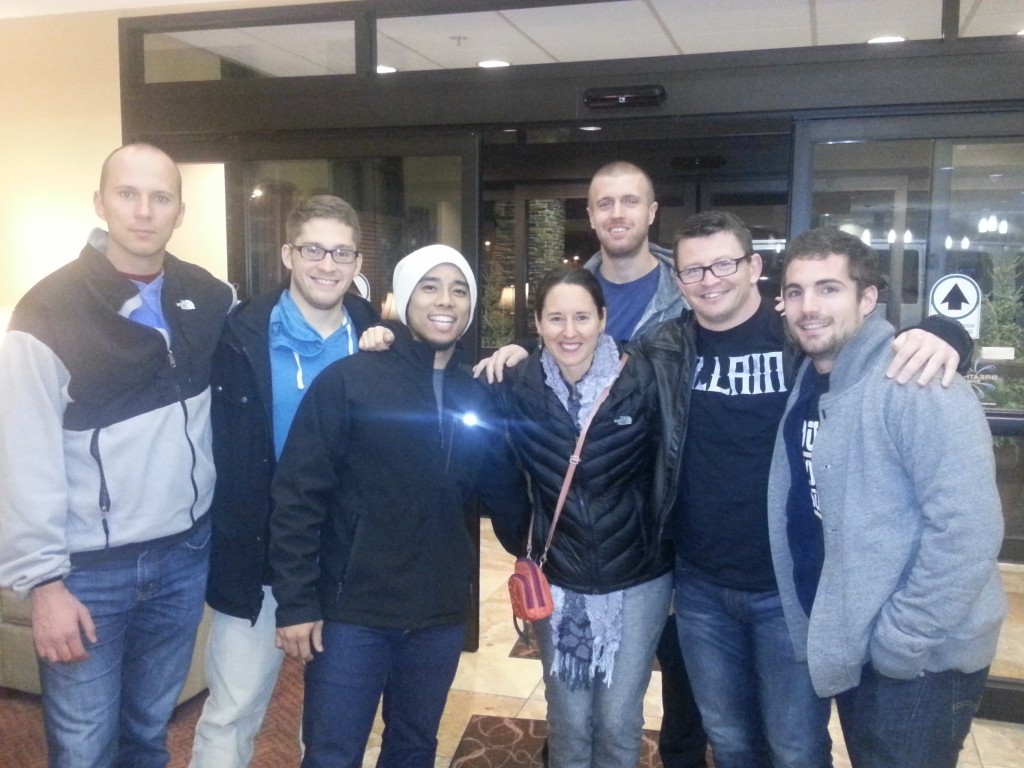This is part IV of a four part series. All parts have all been published, so here is part I, part II, part III, and part IV.
Click here to subscribe to my newletter.
Day 4: Curvature of the Spine
“We’re learning how to get up into space because we can’t handle space down here.”
-Ron Hruska
We started Day 4 talking about swimmers and penguins and people and helices.
Swimmers
“There’s not a swimmer in the world that appreciates the ground.”
-Ron Hruska
Swimmers are not land animals.
To clarify, I’m talking about human swimmers. Not fish, dolphins, or sperm.
Photo credit: trackplc
Swimmers have PENGUIN-ITIS.
“There’s nothing worse than a dripping wet penguin walking into your clinic.”
-Ron Hruska
And for those who know Ethan Grossman, you missed a fantastic joke about a jacked penguin named Ethan.
Dude is yoked.
Swimmers are sagittal monsters with extra lordosis in their low back and kyphosis in their upper back.
But it’s not REALLY a kyphosis or a lordosis. It’s a neurological handicap.
Swimmers cannot appreciate the frontal plane, the ground, or space around them. Hence, neurological handicap. They throw their heads forward so that they can feel their back because that’s the only way they know how to deal with gravity, but now they have no helix.
What in the world do you mean they have no helix?
Photo credit: James Gentry
A helix alternates and reciprocates. The joint-by-joint approach to training is a helix, assuming everything is working correctly. The most obvious helix is DNA. Or maybe that’s just obvious to me because I’m a nerd.
But extrapolate this to anything that has rhythm: music, respiration, sleep-wake cycle, or the gastrointestinal system. As I said, this rabbit hole is DEEP.
Remember the talk on the thorax from Day 3? Swimmers use their arms for life instead of using them to create things.
Probably the weirdest line of the weekend, and, hence, my favorite: These guys are eating a Life cereal called LATISSIMUS.
They want to be compressed and they’re going to do it the only way they know how. They don’t have frontal plane, so they’re going to try to find more sagittal plane. How about instead of letting them compress themselves with their lats, you compress them with a hug?
Then, put them in sidelying and WATCH THEM SWEAT. If they truly have frontal plane, then they have sagittal plane. Maybe then they will be able to find the floor. How do you know when they’ve found the floor? They shake. Make them stronger by making them look weaker.
I know I’m bringing the weird in this post. There are a few bullets that I want to include for the two people who will understand their meaning:
- New PT students will see a kyphosis and a lordosis, NOT a neurological handicap. Keep that in mind. Skepticism is a good thing.
- Breathing is a frontal plane activity.
- I may want to examine you in your swimsuit, because that psychologically prepares you. It will change your mindset and perception, which may change your test results.
Non-patho Compensatory Scoliosis
There are two main types of idiopathic scoliosis discussed during AI: non-patho compensatory and patho compensatory.
Non-patho is a C curve with the lumbar spine oriented to the right. There is a thoracic curve that is convex to the right (meaning the middle of the C is on the right side). A right rib hump is present.
Everyone has this curve underlying due to asymmetry in the human body and the way the spinal joints are shaped. When the top and bottom vertebrae of the curve make an angle greater than 35 degrees, you can start to have organ problems.
It is important to realize that this curve is not just frontal plane, but it’s also a twist.
The non-patho scoliosis clients will present like a L AIC and R BC patterned person, have trouble getting into their left hip, and trouble getting their center of gravity over to the left. Normally, we expect to see a lowered right shoulder, but this may not be quite as pronounced in these cases.
Worth noting is that kids with this curve will have restlessness and fatigue easily.
These people need to secure the pelvis with R AIC myokinematics, then maximize right apical chest wall expansion. Remember, this is frontal plane. Following that comes integration of a left zone of apposition (abs opposing left hemidiaphragm) with left thoracic abduction (thorax to the left) with a right low trap and triceps (helps with inhalation on right side).
Patho Compensatory Scoliosis
Patho is an S curve. The lower lumbar spine is oriented to the left and right trunk rotation may be increased, both evidencing compromised right iliolumbar ligaments. There is still a right thoracic curve, but there is also a left lumbar curve. Therefore, there may be a right upper thorax posterior rib hump with a left lower thorax rib hump.
These people will also present like a L AIC, and may or may not have typical R BC test results.
The nature of the S curve offsets itself. This person’s center of gravity may be over to the left, even if they can’t get IR’d into the left hip. They may still be able to balance well on the left leg. These people will be harder to fix because they don’t “need” to change to get themselves to feel balanced.
People with a patho curve need to get secured into their left hip (left AF IR) while integrating the left IOs/TAs and inhibiting the right adductor. As you can tell, these people also have a huge emphasis on the frontal plane. Following this, they should learn how to abduct their right hip while laying on their left side with their left hip IR’d.
PAUSE: that’s basically the same thing as the first step, just in sidelying.
After left sidelying comes right sidelying left hip abduction. Then you go upright and learn to secure in the left hip while rotating the trunk to the right on one leg.
Learning anecdote: PRI includes treatment sequences like this for all types of diagnoses. I’ve always glossed over them in lieu of learning the basics. It has always just seemed, superficially, that the course of treatment is the same: fix what they need. As I reviewed the treatment for these two scoliosis patterns, I actually found it very helpful. Laying it down on a notecard was worthwhile. I will do more of this in the future.
Vision
Dr. Heidi Wise came up to talk to us about vision. Though this was my first real PRI exposure to visual integration, I took away some things I can use in the gym with my people.
“Do you feel like you use one eye or both?” Don’t put their left side next to a wall if they already feel like they aren’t using their left eye because that removes peripheral space to be noticed.
SIDE NOTE: While writing that, I realized my sweatshirt hood was on and was blocking my ability to perceive space. Took it off and it’s like a weight had been lifted off of my face.
If they stare at the ground a lot, maybe I need them to face out through a window while pushing into it. In initial development, the gross motor and vestibular systems drive vision. Later on, it switches. There needs to be integration of the gross motor mechanical and visual systems.
We need to integrate sight, sound, space, and ground.
Heidi gave us some things we could ask our eye doctors to make sure we aren’t overprescribed:
- “Can you please make sure my eyes aren’t overworking and my vision isn’t overcorrected?”
- “Can you balance my eyes so that they can work the best that they can together?”
Go to COVD.org to find an eye doc who is interested in vision for function.
Go to NORA.cc to find an eye doc for someone with brain injury.
Day 4 Conclusion
The scoliosis section has two pages of references. I wanted to review them all, but I don’t have time for that at this moment. Maybe in the future that will become a write up, but for now, you will lie in wait.
One more thing to note which we talked about briefly in Day 1: between the ages of 7-19, you have more power in terms of advanced integration. The way you inhibit younger individuals is through alternating activity. At 21 years old, however, you need to think more about inhibiting.
You also missed Emily Soiney teaching Ron and I some yoga.
Advanced Integration 2014 Conclusion
Advanced Integration: the monster of the PRI courses.
I leave the fundamental, two-day courses absolutely exhausted. This one is twice as long. As you can imagine, my brain was on vacation after this.
Though this course was heavily theoretical, there were plenty of takeaways. I left with a shift in mindset, a less myopic view of PRI, and plenty of great cues to use on my clients.
As this course was four days long, there is a ton of information I have left out. I highly recommend taking this course, as it helps you understand the more overarching concepts of PRI.
Here’s to a fun weekend with a great group of people! Thank you so much for reading this.







Add some color to this commentary.